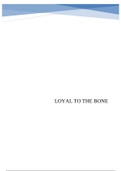LOYAL TO THE BONE
,Content
1. Introducton........................................................................................................................................2
2. Data analysis strategy.........................................................................................................................3
3. Descriptie statstcs...........................................................................................................................5
4. Factor analysis....................................................................................................................................7
4.1 Original Factor analysis.................................................................................................................7
4.2 Iteraton 1.....................................................................................................................................8
4.3 Iteraton 2.....................................................................................................................................9
4.4 Iteraton 3.....................................................................................................................................9
4.5 Factors and factor loadings.........................................................................................................10
5. Reliability analysis.............................................................................................................................11
6. Conclusions and implicatons............................................................................................................12
7. References........................................................................................................................................13
8 Appendix............................................................................................................................................13
8.1 Descriptie statstcs...................................................................................................................13
8.2 Factor Analysis............................................................................................................................14
8.3 Reliability analysis.......................................................................................................................18
1
, 1. Introduction
Nowadays, organizations have to meet different requirements than before. A few, maybe even
less, decades ago, organizations were mainly concerned with the quality of their products and
the price of them. However, those times are gone. Although price and quality are still
important factors, they are not the only ones anymore. Consequently, it is also about ´why´
organizations are selling their particular products, how they operate within their environment
and the way they contribute to society as a whole. These, and many more, aspects can cause
an organization to succeed, but also to fail, in attracting and preserving customers.
The (growing) importance such factors, as environmental friendliness, good working
conditions, fair pay, and contribution to society, can be seen in the increasing popularity of
CSR and research into CSR.
Unfortunately, taking these factors into account is only one side of the coin. In order to truly
attract customer, and more importantly, to retain/keep them, another kind of knowledge is
needed. More specifically, knowledge regarding the retention of customers by understanding
and making use of the concept of customer loyalty, which entails: positive feelings towards a
brand (or retail store) and dedication to purchase the same product or service repeatedly
now and in the future from the same brand (or store), regardless of a competitor's actions or
changes in the environment (Kotler & Keller, 2006, p.85) .
To create a better understanding of this concept, this research sheds a light on the underlying
structure/dimensions of customer loyalty. Consequently, the research question is as follows:
Which factors form the underlying dimensional structure of customer loyalty?
In order to be able to answer this question, existing data, derived from Bloemer, et. al (2002)
The psychology behind commitment and loyalty, an empirical study in a bank setting, is re-
analyzed. While doing this, we take in mind that Bloemer, et.al (2002) concluded that there
were four constructs related to loyalty: “word-of-mouth", "purchase intention, "price
sensitivity" and "complaining behavior". So, more specifically, this research is aimed at
studying the data derived from Bloemer, et. Al (2002) and investigate whether the same
factors will be found. In order to do this, a factor analysis (common factor analysis) will be
conducted, with which the underlying dimensions of customer loyalty can be discovered.
Consequently, the upcoming chapter is about factor analysis and which steps one should take
in order to succeed.
2






